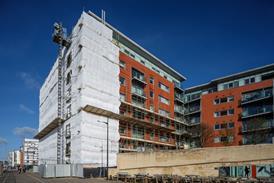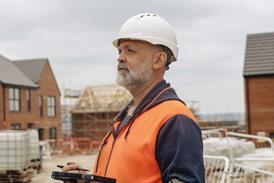Mark Roach and Harriet Hawkins provide an overview of recent developments in the remediation of building safety defects and outline expected changes on the horizon


Keeping up to date with changes to legislation, government policy and case law relating to building safety has been a huge challenge for the profession. The Building Safety Act 2022 (BSA) heralded a major transformation, introducing new rights, powers and protections, along with enhanced regulatory regimes for building safety and construction products. The act has been followed by a myriad of regulations and government initiatives. The period since December 2024 has been particularly dynamic and has included the launch of the government’s Remediation Acceleration Plan (RAP), which was updated with a set of additional measures published in July 2025. In addition to all the recent developments to consider, there are further significant developments on the horizon.
Remediation Acceleration Plan
Labour pledged to accelerate the pace of remediation of building safety defects in its 2024 Change manifesto. On 2 December last year, the new government unveiled its RAP.
The “ambitious approach” set out in the RAP aims to achieve three core objectives:
- fix buildings faster – accelerating remediation of known unsafe buildings
- identify all buildings with unsafe cladding – ensuring all 11m-plus residential buildings with unsafe cladding are identified, and
- support residents – improving the experience of leaseholders and tenants throughout the process.
Through the RAP, the intention is that:
- all cladding remediation on 18m-plus buildings in a government-funded scheme is completed by the end of 2029, and
- every 11m-plus building with unsafe cladding will either have been remediated, have a date for completion, or the landlords will be liable for severe penalties.
The RAP recognises that there were several barriers to making buildings safe, including access to funding, the supply chain of skilled professionals able to meet demands and constrained regulator capacity. Notwithstanding this, the government expects all cladding remediation to be either completed or in progress by 2029. Legislation was promised to create a clear and legal duty on those responsible for 11m-plus buildings to take necessary steps to remediate their buildings within clear timescales.
Update to the RAP
The RAP promised an update in summer 2025, which has now been published. It states that significant progress has been made but sets out a range of additional measures to accelerate progress.
To fix buildings faster, the government announced plans to:
- give social landlords equal access to remediation funding, supported by a joint plan between government, social landlords and regulators to expedite works
- introduce a Remediation Bill, creating a legal duty to remediate with fixed timescales and criminal penalties for non-compliance, and giving new remediation backstop powers to local authorities and Homes England
- tighten fire assessment standards to minimise delays to remediation start dates and provide certainty on the scope of works
- support the delivery of local remediation acceleration plans to enhance collaborative working and expertise at regional levels, and
- establish a national remediation system to serve as the single source of data for all relevant buildings over 11m.
These measures reflect a shift from encouragement to enforcement.
Separately, the government has also published revised estimates of the number of 11m-plus buildings that will require remediation due to unsafe cladding. These show a significant reduction, with estimates of between 500-3,400 buildings with unsafe cladding left to bring into a remediation programme compared with previous estimates of 4,000-7,000.
Legal duty to remediate
Landlords are already responsible for ensuring that their buildings are safe. The proposed Remediation Bill, with its new legal duty to remediate, marks a significant escalation in the government’s approach to accelerate work to fix buildings. The bill is expected to include:
- statutory deadlines for remediation
- criminal sanctions for non-compliance, and
- expanded powers for local authorities and the Building Safety Regulator (BSR) to enforce action.
It will become an offence for any person to obstruct another from assessing or remediating an unsafe building over 11m in height, without a reasonable excuse. A hard “endpoint” will put into law timescales for completing remediation. These will be consistent with the RAP so that by the end of 2029, any landlord who has failed to remediate a building over 18m, without reasonable excuse, will face criminal prosecution and unlimited fines and/or imprisonment. The deadline for buildings between 11m and 18m will be 2031. The government is giving a stark warning – landlords must act now or face increasingly stringent penalties.
The new bill will also give local authorities and Homes England new remediation backstop powers. Where the timeline for completing cladding remediation has passed or if relevant enforcement options have been exhausted, local authorities and Homes England will be able to apply to the First-tier Tribunal (FTT) for permission to undertake remedial works themselves. The landlord will be liable for any costs and, if not met, could have their building subject to an enforced sale to fund repayment.
The BSR will play a more prominent role in enforcing the rules, including the duty to remediate. A new dedicated remediation enforcement unit within the BSR will take forward the enforcement of 18m-plus buildings with unsafe cladding that are not progressing to RAP timescales.
Joint plan to accelerate developer-led remediation
On 2 December 2024, published alongside the RAP, the government also released details of the Joint plan to accelerate developer-led remediation. The government welcomed the commitment of 54 developers signing the developer remediation contract and recognised the progress made by many. Reflecting a commitment to work together, the following actions were agreed:
- To accelerate determinations of which buildings require remedial works, with developers to commit to completing determinations by the end of 2025. The government commits to work with developers to resolve third-party disputes, to publish dispute-resolution guidance, and to support work on template license agreements.
- To improve the quality of assessments used to determine whether buildings require remedial works. Developers will commit to use independent, competent assessors to undertake all assessments of buildings. The government commits to commission sufficient audits of building assessments.
- To accelerate starts and completions of remediation works. Developers commit to start works on at least 80% of their buildings requiring works by the end of July 2026, and 100% by the end of July 2027. The government commits to working with developers and the BSR to minimise avoidable delays and to intensify pressure on any third party that unreasonably blocks progress.
The July 2025 update to the RAP indicates that 39 developers signed up to the Joint plan (which accounts for over 95% of the buildings that require developer-led remediation under the developer remediation contracts). The figures, to the end of April 2025, suggest that developers will fall narrowly short of the 100% target in the Joint plan to assess all buildings by the end of July 2025. While start rates for remediation work have improved, further acceleration will be required to meet the July 2026 and July 2027 targets.

Other recent developments
The BSA was not just about resolving the problems of the past but also focused on improving building safety in the future. There have been significant developments in the past six months.
Grenfell Tower inquiry phase
On 26 February 2025, the government set out its response to the Grenfell Tower Inquiry Phase 2 Report: Government response, which was published on 4 September 2024. The government has adopted each of the 58 recommendations made by the inquiry and the response sets out the government’s long-term vision for reform. It seeks to address the cultural and regulatory failings exposed by the inquiry and signals a broader shift towards transparency, accountability and resident empowerment.
The government has committed to publishing quarterly reports until all the inquiry’s recommendations have been implemented. The first progress report (June 2025) indicates that the overall timeline for delivery of the recommendations will be set out in September’s edition, but the government expects it will take at least four years for all recommendations to be completed.
Construction products reform
The government also published its Construction products reform green paper on 26 February 2025, which sets out a range of proposals for reform of the construction products regime, including proposals that address the Inquiry‘s recommendations.
The consultation closed in May. The government is currently reviewing the feedback and will also review existing redress routes to ensure they support recovery of costs from construction product manufacturers where appropriate.
Approved documents under review
One of the more technical but impactful proposals is the fundamental review of the approved documents by the BSR. These documents, which provide guidance on compliance with Building Regulations, have been criticised for being complex, ambiguous and not user-friendly. A panel of experts has been appointed, and an interim update is expected in early 2026 with the final report scheduled for summer 2026.
In the meantime, a revised version of approved document B (fire safety) was published in March. The government has committed to keep the approved document B under continuous review, and the BSR will consult on further changes in the autumn.
Gateway procedure
The BSA introduced a “gateway” procedure for higher-risk buildings designed to ensure that building safety risks are properly managed throughout the design, construction, and occupation phases. The first check is before planning consent, a second one before construction can start (gateway 2), and then a final check at delivery just before the building can be occupied (gateway 3).
The introduction of these procedures has had unintended consequences, with the industry as a whole experiencing delays due to the time taken to review and high rejection rates at gateway 2. The latest data released by the BSR indicates that it is taking on average 36 weeks to get gateway 2 sign-off on new-builds while the official timeframe is supposed to be 12 weeks. Applications relating to existing buildings are experiencing similar delays. Further, since the regime came into operation in October 2023, only 15 applications of 193 submitted for new-build schemes had been approved at gateway 2. Clearly, there are resource issues.
The BSR is working to address these issues and improve the application process. On 21 July 2025, the Construction Leadership Council, in conjunction with the BSR and industry stakeholders, published guidance, Building control approval application for a new higher-risk building (gateway 2). The government has also promised to continue publishing quarterly performance data for the BSR.
Case law and BSA working group
The courts, along with the FTT, continue to help shape the legislative and BSA framework. Notable cases in the last six months include the Court of Appeal’s decisions in Triathlon Homes LLP v Stratford Village Development Partnership [2025] EWCA Civ 846, Adriatic Land 5 Ltd v Long Leaseholders at Hippersley Point [2025] EWCA Civ 856 and the FTT’s judgments in Grey GR Limited Partnership v Edgewater (Stevenage) Ltd and others (CAM/26UH/HYI/2023/0003) and Empire Square (LON/00BE/HYI/2023/0013 & LON/00BE/BSB/2024/0602) as well as the Supreme Court’s decision in URS Corporation Ltd v BDW Trading Ltd [2025] UKSC 21. Revisions to the Technology & Construction Court (TCC) Guide have also been recommended by the BSA working group to provide guidance on procedural issues and a streamlined resolution process where BSA disputes span the jurisdiction of both the TCC and the FTT.
Looking ahead
These are just some of the recent developments, but there are more on the horizon. As mentioned, there will be a new Remediation Bill, the review of approved documents, amendments to the TCC guide and reform to the regulation of construction products to consider and digest. There is also the new building safety levy, which will come into effect from 1 October 2026; draft regulations and guidance were published on 10 July 2025.
It’s important to note that these developments only relate to England; different regimes are being developed and apply in Wales, Scotland and Northern Ireland.
The post-Grenfell era has ushered in a wave of reform, but the journey is far from over. Developments since December 2024 underscore the government’s commitment to accelerating remediation, enforcing accountability, and empowering residents. Future developments will introduce new duties and obligations to meet, but also new rights and remedies. Enforcement powers will be expanded, guidance will continue to evolve and scrutiny by regulators is likely to increase.
As the regulatory framework continues to evolve, one thing is clear: change is the only constant.




















